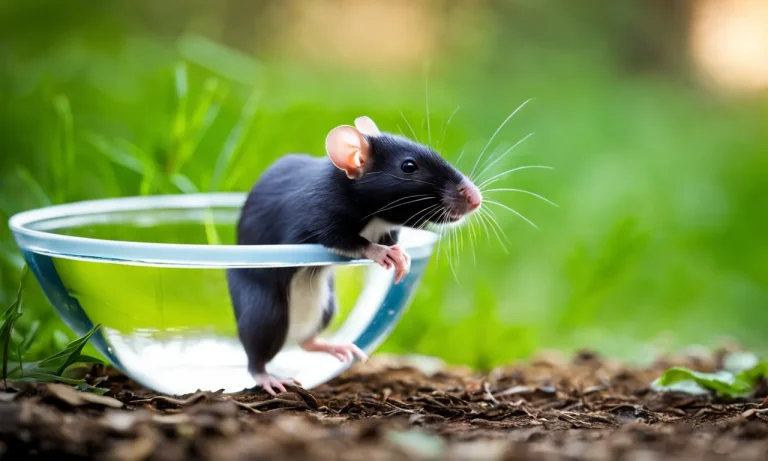Rats have a reputation for spreading diseases and causing property damage. White rats, also known as albino rats, are a domesticated breed often kept as pets. But are white rats dangerous? In this comprehensive guide, we’ll examine the risks and realities surrounding these controversial yet beloved rodents.
If you’re short on time, here’s a quick answer to your question: While domesticated white rats pose little danger, wild rats carry more risks of disease and aggression. Proper handling and containment of pet rats can help mitigate most hazards.
Diseases Carried by Rats
White rats, like all rats, can carry various diseases that can be harmful to humans. It is important to be aware of these diseases and take necessary precautions to prevent any potential health risks. Here are some of the diseases commonly associated with rats:
Hantavirus
Hantavirus is a serious respiratory disease that can be transmitted to humans through the urine, droppings, or saliva of infected rats. Symptoms include fever, muscle aches, and fatigue. In some cases, it can lead to severe respiratory distress and even death.
It is essential to avoid direct contact with rat droppings and maintain good hygiene practices to minimize the risk of hantavirus infection.
Leptospirosis
Leptospirosis is a bacterial infection that can be contracted by coming into contact with water, soil, or food contaminated with the urine of infected rats. Symptoms range from mild flu-like symptoms to severe complications such as liver and kidney damage.
It is crucial to keep living areas clean and eliminate any potential sources of rat infestations to prevent leptospirosis.
Rat-Bite Fever
Rat-bite fever is a bacterial infection that can be transmitted through bites or scratches from infected rats. Symptoms may include fever, chills, joint pain, and skin rash. Prompt medical attention is necessary to treat rat-bite fever, as it can lead to serious complications if left untreated.
Plague
The plague, caused by the bacterium Yersinia pestis, is a highly infectious disease that can be transmitted to humans through fleas that infest rats. While the plague is rare, it can be life-threatening if not treated promptly. Symptoms include fever, swollen lymph nodes, and respiratory distress.
Salmonellosis
Salmonellosis is a bacterial infection that can be contracted by consuming food or water contaminated with rat feces. Symptoms include diarrhea, abdominal pain, and fever. It is important to practice proper food handling and storage to minimize the risk of salmonellosis.
It is important to note that while white rats can carry these diseases, they are not inherently more dangerous than other rats. The risk of contracting these diseases can be significantly reduced by practicing good hygiene, keeping living areas clean, and properly sealing any entry points that may allow rats to enter your home or premises.
For more information on rat-borne diseases and prevention methods, you can visit the Centers for Disease Control and Prevention (CDC) website.
Aggressive Behavior in Rats
While white rats are generally docile and friendly creatures, they can exhibit aggressive behavior in certain situations. Understanding the reasons behind this behavior can help you handle and interact with your pet rat more effectively.
Territorialism
Rats are naturally territorial animals, and this territorial instinct can sometimes lead to aggressive behavior. When a rat feels threatened or perceives another rat invading its territory, it may become aggressive and display defensive behaviors such as biting or lunging.
It’s important to provide each rat with its own space and resources to minimize territorial conflicts.
Fear or Distress
Like any animal, rats can experience fear and distress, which can trigger aggressive responses. If a rat feels threatened or frightened, it may resort to biting or attacking as a means of self-defense.
Creating a calm and stress-free environment for your pet rat can help reduce the chances of aggressive behavior.
Maternal Aggression
Female rats can display aggressive behavior when they are protecting their young. Maternal aggression is a natural instinct that ensures the safety of the litter. While it is important to respect the mother rat’s need to protect her offspring, it’s also crucial to monitor and handle the babies with care to avoid any potential harm.
Pain-Induced Aggression
Rats, like all animals, may exhibit aggression if they are in pain. If a rat is suffering from an injury or illness, it may become defensive and aggressive when approached or handled. If you notice any signs of pain or discomfort in your pet rat, it’s important to seek veterinary attention promptly.
Remember, aggression in rats is not the norm, and most pet rats are friendly and sociable. However, it’s crucial to understand the underlying causes of aggression and take appropriate steps to ensure the well-being of both your pet and yourself.
Risks of Wild vs. Pet Rats
Wild Rats Pose More Threats
When it comes to the risks associated with rats, wild rats generally pose more threats compared to pet rats. Wild rats are known carriers of various diseases, including leptospirosis, hantavirus, and salmonellosis.
These diseases can be transmitted to humans through contact with rat urine, droppings, or bites. Additionally, wild rats can carry fleas, ticks, and mites, which can further spread diseases and cause discomfort.
In contrast, pet rats are bred in controlled environments and are less likely to carry diseases or parasites. However, it is important to note that although the risk is lower, pet rats can still potentially transmit certain diseases to humans.
It is crucial to maintain good hygiene practices and regular veterinary care to minimize these risks.
According to the Centers for Disease Control and Prevention (CDC), pet rats have been linked to a few cases of a bacterial infection called rat bite fever. However, these cases are rare, and with proper handling and care, the risk can be significantly reduced.
Proper Care Minimizes Pet Rat Risks
While pet rats may pose fewer risks compared to wild rats, it is essential to provide them with proper care to minimize any potential dangers. Regular veterinary check-ups, appropriate housing, and a balanced diet are crucial for maintaining the health and well-being of pet rats.
It is also important to handle pet rats gently and avoid any rough play or actions that may lead to bites or injuries. By providing a clean and safe environment, along with regular socialization and mental stimulation, the risk of aggression or territorial behavior can be minimized.
Furthermore, maintaining good hygiene practices is essential when handling pet rats. Regularly cleaning the cage, washing hands before and after handling, and avoiding contact with their urine or droppings can help prevent the spread of any potential diseases.
Choosing the Right Pet Rat
When considering a pet rat, it is important to choose the right one for your lifestyle and preferences. There are different breeds and varieties of rats, each with their own characteristics and temperaments.
If you are looking for a pet rat that is more sociable and affectionate, consider getting a domesticated rat bred for companionship. These rats are often friendly, enjoy human interaction, and can make great pets for individuals or families.
On the other hand, if you prefer a more independent rat that requires less handling, you may opt for a rat bred for show or breeding purposes. These rats are typically less inclined to seek human interaction but can still make wonderful pets with proper care and attention.
It is also important to choose a rat from a reputable source, such as a responsible breeder or a reputable pet store. This ensures that the rat has been bred in a healthy and controlled environment, reducing the risk of potential health issues.
For more information on pet rat care and choosing the right rat, you can visit reputable websites such as the American Fancy Rat and Mouse Association (AFRMA) at www.afrma.org.
Safe Handling of Pet Rats
When it comes to handling pet rats, it is important to prioritize their safety as well as your own. Rats are generally friendly and gentle creatures, but it is still necessary to follow certain guidelines to ensure a positive interaction. Here are some tips to help you handle your pet rats safely:
Supervise Children
If you have children, it is crucial to supervise their interactions with pet rats. While rats can make wonderful pets for children, it is important to teach them how to handle them properly. Children should be taught to handle rats gently and avoid any rough or aggressive behavior.
It is also important to emphasize the importance of washing hands before and after handling the rats, as this helps to prevent the spread of any potential bacteria.
Support Entire Body
When picking up a rat, it is essential to support their entire body. Rats have delicate bones and muscles, and improper handling can cause them stress or even injury. Place one hand under their chest and the other hand gently around their hindquarters.
This provides them with a secure and comfortable grip, ensuring their safety and reducing the risk of them squirming or attempting to escape.
Avoid Quick Movements
Rats are sensitive creatures and can easily get startled by sudden or quick movements. When handling them, it is important to move slowly and calmly. This helps to build trust between you and your pet rat, creating a positive and stress-free environment for them.
Additionally, avoiding sudden movements reduces the risk of accidentally dropping or mishandling the rat, ensuring their safety.
Watch for Warning Signs
While most pet rats are friendly and sociable, it is essential to watch for any warning signs that they may be feeling uncomfortable or stressed. Some signs to look out for include excessive squirming, hissing, biting, or trying to escape from your grasp.
If you notice any of these behaviors, gently place your rat back in their cage and give them some space. It is important to respect their boundaries and give them time to relax and feel safe.
Remember, handling your pet rat should be a positive and enjoyable experience for both of you. By following these guidelines, you can ensure the safety and well-being of your pet rat while strengthening the bond between you.
Containment Tips for Pet Rats
When it comes to keeping pet rats, containment is crucial to ensure their safety and prevent any potential hazards. Here are some tips to help you create a secure environment for your furry friends:
Escape-Proof Cage
Investing in a sturdy and escape-proof cage is the first step in containing your pet rats. Make sure the cage has narrow bar spacing to prevent them from squeezing through, and secure all doors and openings properly.
It’s also important to choose a cage with multiple levels and plenty of space for your rats to climb, explore, and exercise.
Minimize Free-Roaming
While it’s tempting to let your pet rats roam freely around your home, it’s important to minimize their free-roaming time to ensure their safety. Rats are curious creatures and can easily find themselves in dangerous situations, such as chewing on electrical wires or ingesting toxic substances.
Instead, create a designated play area where your rats can safely explore and interact with you under supervision.
Designate Rat-Safe Zones
When your pet rats are out of their cage, it’s essential to designate rat-safe zones in your home. These areas should be free from any potential dangers or hazards. Ensure that there are no open windows or doors that could allow your rats to escape, and remove any toxic plants or chemicals from their reach.
Rat-proofing these zones will give you peace of mind while allowing your rats to have supervised playtime outside their cage.
Block Access Points
Rats are skilled climbers and can squeeze through surprisingly small openings. To prevent any accidental escapes or access to restricted areas, thoroughly inspect your home for potential access points.
Seal any gaps or holes in walls, floorboards, or furniture that could serve as entry points for your curious pets. Pay attention to areas around pipes, vents, and wiring as rats can easily navigate through these spaces.
By following these containment tips, you can create a safe and secure environment for your pet rats to thrive. Remember, rats are intelligent and curious animals, so providing them with engaging toys, hiding spots, and regular interaction will keep them happy and entertained.
Conclusion
While albino rats can make wonderful pets, proper precautions are needed to avoid potential hazards. With attentive care and handling, pet rats pose minimal risks of transmitting disease or inflicting harm.
By understanding rat behavior and containment best practices, owners can keep their pet rats – and households – safe and happy.






